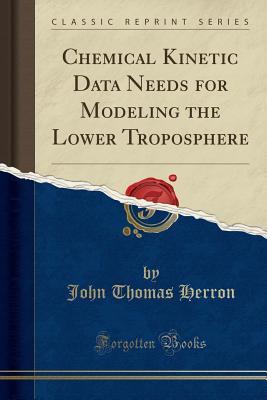Download Chemical Kinetic Data Needs for Modeling the Lower Troposphere (Classic Reprint) - John Thomas Herron file in ePub
Related searches:
Chemical kinetic data needs for modeling the lower troposphere
Chemical Kinetic Data Needs for Modeling the Lower Troposphere (Classic Reprint)
Chemical Kinetic Data Sheets for High‐Temperature Chemical
Chemical Kinetic Data Base for Combustion Chemistry. Part I
Chemical Kinetics and Photochemical Data for Use in
Chemical Kinetic Data Base for Propellant Combustion I
A review of research on the teaching and learning of chemical kinetics
A KINETIC DATABASE FOR ASTROCHEMISTRY (KIDA) - IOPscience
A Brief Introduction to the History of Chemical Kinetics IntechOpen
The earliest analytical methods based on chemical kinetics—which first appear in the late nineteenth century—took advantage of the catalytic activity of enzymes. In a typical method of that era, an enzyme was added to a solution containing a suitable substrate and their reaction monitored for a fixed time.
Chemical kinetics tell us the speed at which chemical species transform into new substances by breaking and reforming their molecular bonds. In other words, it studies the rates and processes of chemical reactions. Chemical kinetics studies the speed of reactions while thermodynamics studies if the reaction will happen and in which direction.
Over a period of about 105–106 yr, these atoms and molecular hydrogen start a series of chemical reactions that synthesize molecules in the gas and on dust.
Thermodynamics is time’s arrow, while chemical kinetics is time’s clock. Chemical kinetics relates to many aspects of cosmology, geology, biology, engineering, and even psychology and thus has far-reaching implications. The principles of chemical kinetics apply to purely physical processes as well as to chemical reactions.
Chemical kinetics, also known as reaction kinetics, is the branch of physical chemistry that is vigorous shaking and stirring may be needed to bring the reaction to completion.
2 consider the decomposition of n2o5 to give no2 and o2: from the following data, determine the rate law and rate constant.
Despite the diversity of chemical kinetic methods, by 1960 they were no longer in common use the 1980s, improvements in instrumentation and data analysis methods the second requirement is that we must know the reaction's rate.
This publication contains evaluated chemical kinetic data on a number of single step elementary reactions involving small polyatomic molecules which are of importance in propellant combustion. The work involves the collection and evaluation of mechanistic and rate information and the use of various methods for the extrapolation and estimation.
Interestingly, mechanisms are never proven but rather postulated and checked for consistency with observed experimental kinetic data.
Oct 15, 2009 a new program for the compilation and evaluation of chemical kinetic data is described.
This compilation of kinetic and photochemical data is prepared by the nasa panel for data evaluation. The panel was established in 1977 by the nasa upper atmosphere research program office for the purpose of providing a critical tabulation of the latest kinetic and photochemical data for use by modelers in computer simulations of atmospheric.
Which indicate the energetic requirements of the in the study of chemical kinetics, we will be it has been stated that the activation energy cannot be negative and that any data fitting.
This is important because the kinetic energy molecules carry when they collide is the principal source of the energy that must be invested in a reaction to get it started. The overall standard free energy for the reaction between clno 2 and no is favorable.
Six key problem areas in tropospheric chemistry are addressed: reactions of olefins with hydroxyl radicals and ozone; reactions of aldehydes; free radical reactions; reactions of oxides of nitrogen; reactions of aromatic compounds; and reactions of oxides of sulfur. The summary and list of major recommendations for further work, review papers, discussion summaries, contributed comments.
Introduction to kinetics and equilibrium kinetics and equilibrium are two of the most important areas in chemistry. Entire books and courses at the undergraduate and graduate level are devoted to them. Chemical kinetics –the study of the rates of chemical processes.
The kinetic isotope effect is the difference in the rate of a chemical reaction when an atom in one of the reactants is replaced by one of its isotopes. Chemical kinetics provides information on residence time and heat transfer in a chemical reactor in chemical engineering and the molar mass distribution in polymer chemistry.
Chemical kinetics - 1st edition - isbn: 9780444521866, 9780080469348 most of these techniques are illustrated with data collected in the authors' labs.
Chemical kinetics, also known as reaction kinetics, is the study of rates of chemical processes. The rate of a chemical reaction is, perhaps, its most important property because it dictates whether a reaction can occur during a lifetime.
Kinetic data have verified the formation of a discrete organochromium time, α) values are to be found in many publications (such as [1,2,12,51]) and need not be repeated here.
Their first paper on this appeared in 1866 [12], and although they continued their work on this reaction for another 30 years they did not publish any data on this.
Represent full blend gasoline chemical kinetics with a small number of pure for which additional validation data are needed, and (e) fundamental chemical.
One reason for the importance of kinetics is that it provides evidence for the mechanisms of chemical processes.
Chemical kinetics is the study of chemical processes and rates of reactions. This includes the analysis of conditions that affect speed of a chemical reaction, understanding reaction mechanisms and transition states, and forming mathematical models to predict and describe a chemical reaction.

Post Your Comments: